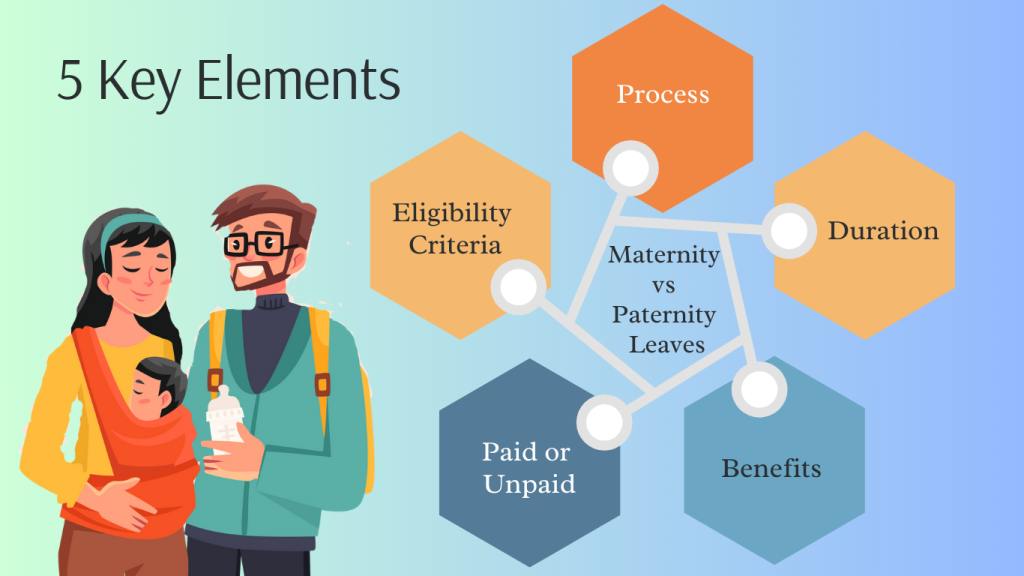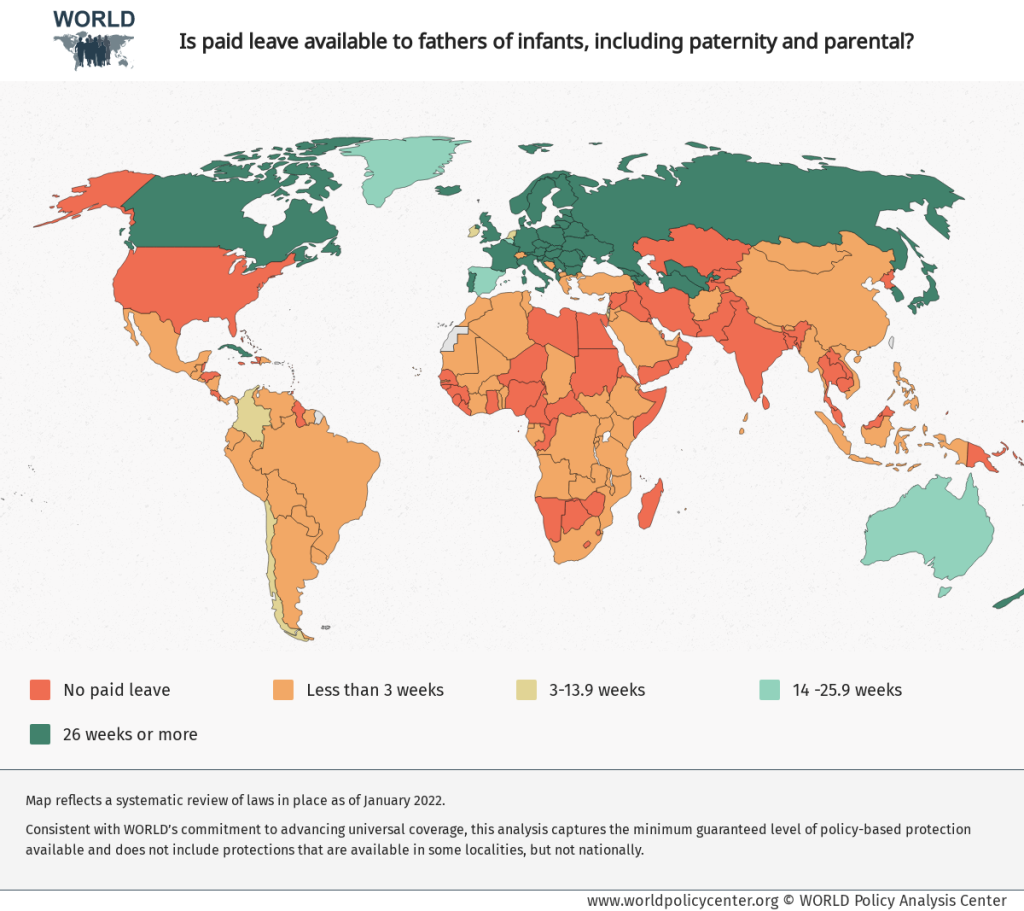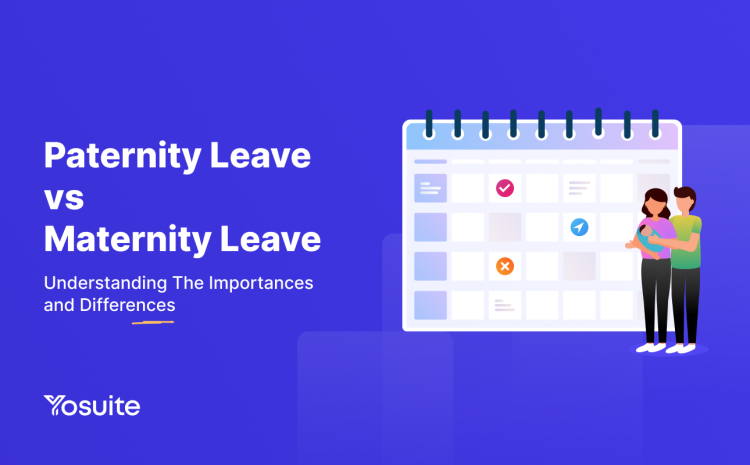Nothing beats a memorable snap with your newborn or little one. But if you are a working parent, is managing this cherished moment so easy?
NO, not really, even if you live in a developed nation like the US.
The importance of paternity leave and maternity leave is undeniable; not merely because you get to enjoy time off with your new one, but also because you transform as a parent in a better way.
Here, we unpack the essentials of paternity leave vs maternity leave, any differences, and some region-wise comparison of the regulations that shape the implementation of these leaves.
Table of Contents
What are Paternity Leave & Maternity Leave?
More common between the two, Maternity Leave refers to the duration of leave that a female worker can enjoy pre-, during, and post-pregnancy.
Similarly, men can also avail a certain duration of leave, when their partners have just given birth to a baby. This is called paternity leave.
But if you ask, what is the difference between maternity and paternity leave? The basic difference is the duration and benefits as expecting mothers usually get more of these.
There is another term, Parental Leave, which at times is interchangeably used with maternity and paternity leave. But, is parental leave the same as maternity leave? No. Let’s see why.
What is Parental Leave?
A broader term that encompasses both is parental leave. This term generally means an employment benefit that enables working parents to take time off from their jobs to care for, nurture, and establish a bond with their children, newborn or not.
Parental leave can be either paid leave, unpaid leave, or a mix of both, depending on local laws. Availing this leave does not count against the employee’s attendance tracking, the most basic element of payroll.
In many countries, parental leave can include leaves taken by adoptive parents or guardians, too. Usually, HR departments include a separate section on leave entitlements in their employee handbooks or manuals. This is also communicated to employees during onboarding as a best practice.
Please note: five countries in the world DO NOT mandate any federal policy allowing paid parental leaves of any sort. They are:
- United States
- Marshall Islands
- Micronesia
- Palau
- Papua New Guinea
These nations offer paternity and maternity leaves under case-to-case basis or at selected cities/states, enforced by particular acts, paid or unpaid.
Key Elements: Maternity vs Paternity Leave
Employers in many countries understand the importance of paternity leave vs. maternity leave as this is availed at strenuous times, especially for a woman. Thus, the employers offer paid leaves, per company or regulatory policies, to assist the new parents. Let’s delve into the key elements of paternity leave vs. maternity leave implementations across different regions.
Eligibility Criteria
Getting parental leaves like paternity and maternity leave varies in selective metrics but are generally similar across regions and genders. For example in Canada, an employee is eligible for Paternity Leave, if they served at least 600 hours of work within the last 52 weeks. In Japan, paternity leave can be availed only if one completes at least one year of tenure with the employer. Likewise, in the UK, one is eligible only if they are employed at an organization for at least 26 weeks up to any day in the 15th week before the baby is due.
In case of maternity leave, most organizations globally need you to be:
- ✔️ pregnant or have recently given birth
- ✔️ mother caring for your newborn
- ✔️ newly adoptive parent when requesting parental benefits
Also, like paternity leave, maternity benefits require at least a certain amount of work time with the employer before enjoying it.
However, in some countries, the father can only avail paternity leave if certain conditions are met. A condition could be the death or incapacitation of the biological mother.
Among the top, developed countries in the world, only the USA requires specific eligibility criteria under the Family and Medical Leave Act (FMLA) to avail maternity or paternity benefits:
- Covered employers are operating in the private sector with 50 or more employees, or are public agencies, or local educational agencies.
- Eligible employees have worked for the employer for 12 months or more
- Eligible employees have worked a total of at least 1,250 hours for the covered employer.
Process
Most countries that allow parental leaves require a written notice before delivery of the child or during pregnancy for availing of maternity leave benefits. For instance, a female worker in the UK, must notify her employer 15 weeks before the due date to avail paid maternity leave. In the US, expecting mothers should notify the employer 30 days in advance as per FMLA. As for a country like India, maternity benefits may be availed only after notifying in writing not before 6 weeks of due date.
As for paternity leave, similar rule applies of notifying beforehand with availing leave. In Canada, fathers can avail either Standard parental or Extended Parental Leaves giving two weeks notice, specifying the number of weeks’ leave they want to avail. But in Australia, a notice of at least 10 weeks before your child’s expected date of birth or adoption is expected.
In the US, however, the notice period is 30 days. And, as per the FMLA and state laws, employers are bound to create parental leave policies that are equal for both male and female employees. For instance, offering longer maternity leave than paternity leave is a direct violation of Title VII of the Civil Rights Act, which prohibits gender discrimination.
In most organizations and countries, after approval of any kind of paternity or maternity leave, the employee should complete their assignments or transfer those to another team member, after consulting with the team lead or manager.
Duration
Maternity and paternity leave duration varies across regions and companies. Some policies allow long durations with partial pays. Other entitle shorter durations but with full pay.
For instance, Sweden currently allows 69 weeks of maternity leave, longest for any country. Likewise, Japan provides 14 months of paternity leave, well ahead of any country in the world when it comes to fathers. However, that includes both post-childbirth leave of 8 weeks and childcare leave of 12 months.
Vacation Tracker provides a comprehensive list of Maternity and Paternity Leave policies to support new parents.
Policies related to parental leave in the US range from four to twelve weeks. Sometimes even more. As per FMLA, the unpaid time off for a pregnant female worker availing maternity leave is a maximum of 12 weeks, available within 12 months. This rule applies to paternity leave and adoption leave as well.
Paid or Unpaid
Pay benefits for on-leave employees enjoying parental leaves applies differently across companies, cities, countries, and regions.
There are 22 countries in the world that offer 100% paid maternity leave benefits. In contrast, only 4 known major countries – Norway, Slovenia, Spain, and Sweden – avail full 100% paid paternity leave in some capacity.
More than 120 Nations provide Paid Maternity Leave and over 90 nations offer paid paternity leave.
Several states in the U.S. have passed paid family and medical leave laws like many other countries worldwide. However, the rest of the states only allow unpaid leaves only under FMLA.
Benefits
Now, let’s look at what benefits new parents receive from paternity and maternity leaves.
✅ Striking a Work-Life Balance
Paid or unpaid leaves allow flexible work schedules, which help employees strike a proper work-life balance in these sensitive ante or post-natal times.
Employees performing parental responsibilities can avail shifting of work hours, taking time off during the usual workday, or working remotely.
Ensuring work-life balance is a tremendous morale booster for employees, creating stronger trust in the organization, regardless of paternity or maternity leave.
✅ Job Safety Policies
Any leave policy allows employees the right to leave and return, given they notify the employer as per rule and avail leaves as per regulation. This factor also protects them from losing their job, whether the leave is paid or unpaid.
For instance, the FMLA in the USA assures employees that they can return to work, in their same position, after availing leave for valid reasons. In fact, the law enforces that, in case the ‘on-leave’ employee’s position or job is no longer vacant upon his/her return, the employer is bound to give an alternative job to the returning worker, with equal pay and status of the filled position.
✅ Ensuring Gender Equality
Availing leaves for both mothers and fathers helps promote gender equality at work and home. This aspect also boosts employee wellbeing, satisfaction, and overall performance and productivity. It also helps men not feel that they are left out of the benefit.
A Mckinsey report stated that 90% of the men surveyed informed that they saw their relationship improve and flourish with their partner when they took paternity leave and helped in child raising.
✅ Support Programs
Employers can offer benefits programs, like employee assistance programs (EAPs), to employees availing parental leave. EAP provides counseling services, stress-relief support, and assistance on work-life balance.
These workshops help male and female workers understand deeper issues of infant care and why it’s not only limited to mothers.
✅ Improves Family Wellbeing & Bonding
Women and men enjoying parental leaves help a family’s overall well-being. As newborns tend to stay closer to their parents, women enjoying maternity leave (if paid, better) are likely to have better mental and physical health. This eventually improves work performance.

Role of FMLA in Paternity Leave vs Maternity Leave
Unlike many countries and regions, the United States of America does NOT mandate any federal policy allowing paid parental leaves of any sort, maternity or paternity. Barring a few states, the US still does not provide paid benefits for expecting mothers.
So, to provide some respite to the employees expecting a bundle of joy in their lives, FMLA was established. As per the US Department of Labor, this act “entitles eligible employees of covered employers to take unpaid, job-protected leave for specified family and medical reasons with continuation of group health insurance coverage under the same terms and conditions as if the employee had not taken leave.”
Challenges of Paternity vs Maternity Leave
Let’s now look at some challenges of maternity and paternity leaves:
⚠️ Leave Regulations
In countries like the US, where no Federal laws regarding paternity or maternity leaves exist, the generosity of the leave benefits vary per state. For instance, employers in states with PFML, provide paid leaves ranging from four weeks to twelve weeks. This might be favorable for employees in one organization but not in the other.
Then again, some companies prioritize EAPs or employee well-being in contrast to other employers who might prefer availing flexible work hours or generous parental leave. When no concrete rule exists, benefits vary noticeably.
⚠️ Possible Impact on Business
Many employers emphasize economic and business performance over other elements. In such cases, parental leave policies are heavily affected by the employer’s take on absenteeism’s impact on business.
Employers may not value the potential impact of parental leave policies on employee morale, productivity, or job satisfaction.
⚠️ Employee Expectations
There is always a need to ensure the happiness of employees, especially to retain the top performers. If an employer, operating in the US, does NOT offer paid leaves under, and fails to meet a top-performing employee’s expectations during childbirth or postnatal times, there is a good chance they should switch to a company availing FMLA with paid leaves.
Top talents today want family-friendly workplaces, added work benefits, and gender-neutral parental leave policies. Trends suggest that workplace culture and employee benefits play a stronger role in retaining and attracting talents than simply paying a hefty salary.
⚠️ Complexity of Conditions
As many different leave laws exist across the regions, implementing the leave policies can be a bit confusing for the HR departments in various cities.
For instance, in the US, Paid Sick Leave is not the same as paid leave covered under Paid Family and Medical Leave. The differences lie with the eligibility factors to avail of these leaves.
Another complexity exists with the requirement of who pays for PFML. This varies as per state law. It could be a two-sided thing, where both employers or employees contribute to a paid leave fund. Or it could be just one side contributing.
Additionally, there are the challenges of tackling issues like what if:
- Is there stillbirth or infant death during maternity leave ❓
- local laws related to pregnancy changes ❓
- This the second, third, or higher number of children ❓
These complex issues have varying implications, sometimes not covered in the HR Manual.
For example, in the UK, if one unfortunately faces a stillbirth, or a newborn baby dies after surviving for a few days or hours, they are entitled to maternity benefits. Even if this takes place before the 24th week of pregnancy.
Maternity leave vs Paternity leave: Few Key Stats
Following are five key statistics that depict parental leave trends in the world:
➡️ Only 11 US states have paid leaves effective. Seven more will be effective soon.
➡️ Around 18% of US demographics face economic hardship created by unpaid leaves.

Calculations of the Current Population Survey Annual Social and Economic Supplement, 2014-2017
➡️ Bulgaria offers 410 days of Maternity Leave at 90% of monthly pay.
➡️ 63% of countries entitle paid paternity leave, as reported by World Policy Analysis Center

➡️ As per IMPAQ, there is a 92.3% chance of female employees returning to the same employer after giving birth, if they get to use paid leave.
Final Words
Availing parental leaves like paternity and maternity leave is essential for improving employee trust, loyalty, and morale in an organization. Encouraging the entitlement of these leaves helps to attract and retain top performers. This automatically enhances long-term productivity and performance.
However, there are a few concerns that allowing these leaves can hit business and organizational operations, and gender equality issues may creep in given the role of a father and mother before and after the birth of a child. However, the long-term benefits outweigh the short-term challenges. And, major countries like the US can implement the PFML across more states to reap the benefits.
Want to enrich your HR-related knowledge further?
Then, read our articles on 👉 YoSuite Blog👈 and delve into prominent HRM issues and technologies.



Leave a Reply